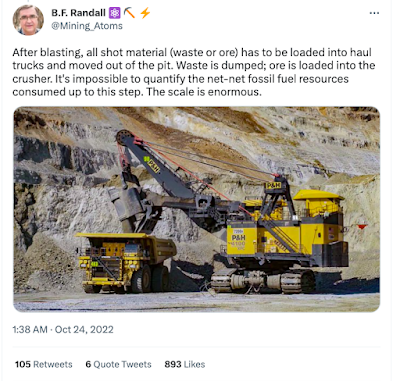Do you remember the claim that energy transition is not possible because mining machines run on DIESEL, and that they burn 1000l of fuel in 12h to extract materials for ONE Tesla battery?
Other twitter experts have had their turn in analysing game too but with even less analytic success, I would argue.
Visa Siekkinen
Turns out that it's not exactly the case. We have options and even in the ARCTIC winter.
B.F.R who lives next to one of the largest open pit copper mines, and have several years of mine management experience, was not able to quantify the fossil fuel consumption of mining. "It's impossible to quantify the net-net fossil fuel consumed"
 |
| B.F. Randall claims that it's impossible to quantify fossil fuel consumption. |
Other twitter experts have had their turn in analysing game too but with even less analytic success, I would argue.
 |
| Similar biased claim in Twitter. |
What a coincidence that Sir Cold957 give it a go with the same CAT994a loader specs, a day after Casper's post.
By the way, that bucket in CAT994 heavy LOADER have a 19-43 m3 load capacity, and the lifting capacity is up to 54 tons.
 |
| Surprisingly similar claim from another account. |
While, I'm not a MINING expert either, a full truck load equals around 250 tons of rock.
If it takes 12h for a loader to fill up a load (5 buckets) there would be 16 trucks waiting their turn to get a load in Kevitsa Mine. 1000l/ 12h/ fuel for five buckets? Give me a break.
 |
| Actual bucket and truck load size. |
A small Finnish equipment magazine was more successful in finding fossil fuel consumption information than Randall or Casper. During the ascent phase of ore transportation a full 227 ton net-load earthmover consumes 15l diesel per 0,5 km. That is a lot.
 |
| Electric truck in an artic climate. Boliden Aitik. |
That's why, options are already implemented and a Swedish mining company Boliden, made an investment to build electric uphill lines for the mining pit road. Their trucks use electricity going up from the pit to the facility with impressive results ❄️. (Image: Boliden Aitik)
In Boliden Kevitsa mine they are replacing 13 diesel earthmovers with Komatsu 830E-5 electric-hybrid variants which will:
- reduce diesel consumption up to 4,5 million litres/a
- reduce total CO2 emission of the whole mine 9%
- increase the ore transportation power by 20-25%
Long story short, turns out that
even in mining industry
the faster you go electric,
the faster you go up the hill, and
the less mineral related emissions emissions we will have.
17.12.2023
Original thread:

Comments
Post a Comment